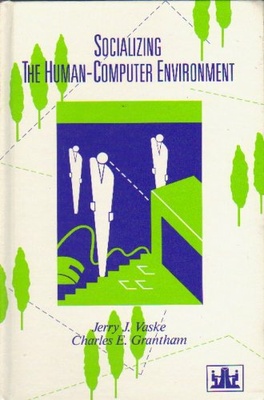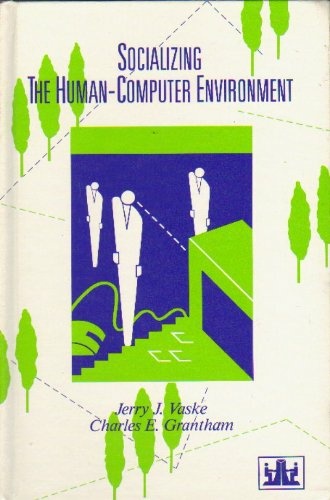Socializing the Human-Computer Environment (Book)
This book calls attention to the social consequences of human-computer interaction and begins developing a theoretical framework that recognizes the interdisciplinary nature of the interactions that occur. This volume is a blend of theory, research and application. It offers alternative perspectives, discussions and questions to consider.
Edition
In this text, the authors call attention to the social consequences of human-computer interaction and begin the process of developing a theoretical framework that recognizes the interdisciplinary nature of the interactions that occur between people and machines. Theories found in social psychology, sociology, and anthropology are used to illustrate how these disciplines can facilitate our understanding of the social processes, underlying human-computer interactions and how this understanding benefits the design, development and implementation of computer systems. This volume represents a blend of theory, research and application. The theory chapters offer alternative perspectives on issues that should be considered by system designers and managers. Each of the chapters follow a similar format. Variables commonly used by a given discipline are examined first, followed by a discussion of the theoretical perspectives relevant to that social science. Each major section concludes with a series of questions researchers can consider when designing new projects and managers can use when implementing approaches to studying the impacts computers have on people.
Preface vii
Chapter 1
Introduction 1
Why This Book is Needed 3
Theories and Theoretical Perspectives 6
Social Psychology 7
Social Organizations 11
Anthropology 14
Integrating the Perspectives 17
Applying Social Science 18
Book Overview 19
Bibliography 20
Chapter 2
The Social Psychology of Human-Computer Interaction 23
The Scope of Social Psychology 25
Researcher's Agenda 28
Manager's Agenda 28
Computer Socialization 29
Researcher's Agenda 31
Manager's Agenda 32
Attitude Theory 32
Definition of Attitude 33
An Attitude is Relatively Enduring 33
An Attitude is an Organization of Beliefs 35
An Attitude is Organized Around an Object or Situation 40
An Attitude is a Set of Interrelated Predispositions to Respond 41
Attitudes Lead to Preferential Responses 41
Summary 42
Researcher's Agenda 42
Manager's Agenda 43
Attitudes and Behavior 43
Attitude-Behavior Models 43
Fishbein and Ajzen Model 43
Bentler and Speckart Model 46
Attitude-Behavior: An Empirical Example 49
Behavior-Attitude Models 51
Researcher's Agenda 54
Manager's Agenda 55
Individual Differences 55
Personality Traits 56
Perceived Locus of Control 58
Extraversion-Introversion 59
Fear of Failure/Need for Achievement 59
Anxiety 60
Defensive mechanisms 61
Cognitive Style 62
Field-dependent/Field-independent 62
Systematic/Heuristic 63
Verbalizers/Visualizers 63
Flexibility versus Rigidity 64
Demographic/Situational Variables 64
Sex-typing and Personality Development 65
Age 65
Education 66
Prior Experience 67
Usage Classification Schemes 68
Researcher's Agenda 69
Manager's Agenda 70
Normative Influences 70
Social Norms 72
Personal Norms 72
The Return Potential Model 73
Researcher's Agenda 76
Manager's Agenda 77
Group Productivity and Cooperative Work 77
Defining Group Productivity 77
Factors Affecting Group Productivity 78
Group Tasks 78
Group Size 80
Group Cohesiveness 81
Communication Network Structure 82
Social Psychological Aspects of
Computer Mediated Communication 82
Current CSCW Research 85
An Empirical Example 86
Researcher's Agenda 89
Manager's Agenda 89
Chapter Summary 90
Bibliography 93
Chapter 3
Organizational Influences and Theories 105
The Nature of Human Organizations 106
Researcher's Agenda 107
Manager's Agenda 108
Organization Analysis Variables 108
Authority and Power 108
Size and Complexity 110
Efficiency and Effectiveness 111
Information 111
Technology 113
Environment 114
Researcher's Agenda 115
Manager's Agenda 116
Theories of Social Organizations 116
The Structural Approach 117
The Bureaucracy of Max Weber 118
The Scientific Management Perspective 122
Applying the Structural Perspective 124
Summary - The Structural Perspective 130
Researcher's Agenda 130
Manager's Agenda 131
The Human Relations School 131
Human Need 133
Maslow's Need Hierarchy Theory 134
McGregor's Theory X and Theory Y 136
Personality and Organization 138
Ouchi's Theory Z 140
Critique of the Human Relations Perspective 141
Researcher's Agenda 142
Manager's Agenda 143
Open Systems Theory 143
Sociotechnical Design 145
Models of Innovation 147
Parameter Estimation 148
An Empirical Example 149
Researcher's Agenda 151
Manager's Agenda 151
Chapter Summary 152
Bibliography 153
Chapter 4
Anthropology: The Symbols of Meaning 163
The Scope of Anthropology 166
The Concept of Culture 167
Researcher's Agenda 170
Manager's Agenda 171
Anthropological Variables 171
Symbols 171
Rituals 174
Myths 176
Researcher's Agenda 179
Manager's Agenda 179
Theories in Anthropology 179
Linguistics 181
Structural Anthropology 181
Pragmatism 184
Cognitive Anthropology 186
Ecological Theory 189
Symbolic Interactionism 193
Researcher's Agenda 196
Manager's Agenda 198
Applying Anthropological Theories 199
An Example from the Software Games Industry 199
Chapter Summary 200
Bibliography 202
Chapter 5
Measurement and Evaluation 209
Overview of the Methodologies 210
Observation of Behavior 213
Participant Observation 213
Thinking Aloud 214
Software Monitor Observation 215
The Development of a Software Monitor Package 217
Special Problems of Multiuser System Monitoring 217
Empirical Examples 219
Empirical Example 1: Office Automation Usage 220
Empirical Example 2: Electronic Mail 221
Summary- Software Monitor 224
Ethical Issues 226
Summary- Observation of Behavior 227
Design Team Techniques 228
Advantages of Committees 230
Disadvantages of Committees 231
The Delphi Procedure 232
Conducting a Delphi Sequence 233
The Nominal Group 236
Experiments 237
Common experimental designs 240
Empirical Example 242
Results 243
Example Summary 250
Surveys 251
The Survey Research Process 253
Types of Questionnaires 258
Mail versus Telephone versus Personal Interviews 258
Electronic Surveys 260
Empirical Example 262
Selected Survey Findings 263
Summary - Surveys 265
Chapter Summary 266
Bibliography 267
Author Index 275
Subject Index 285




